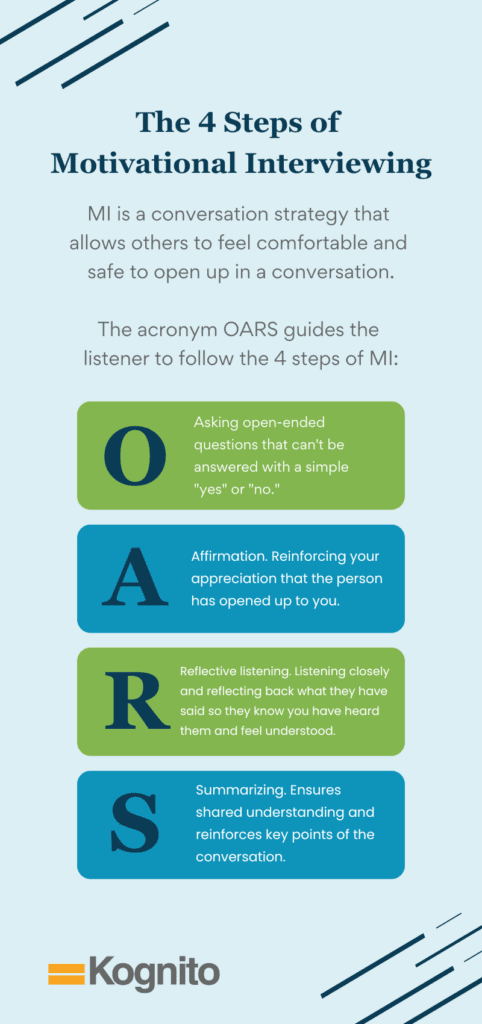The 4 Steps of Motivational Interviewing
Motivational Interviewing (MI) plays an important role when it comes to discussing mental health or positive decision-making with children, teens, and adults. This evidence-based communication strategy allows others to feel safe and comfortable when they open up during a conversation. It can be used by educators, parents, and peers to help others find positive behavioral changes.
When it comes to MI, there are 4 important components that the listener should know. This can be remembered with the acronym OARS.
Using OARS to Remember the 4 Steps of MI
When utilizing MI techniques, it’s important for the listener in the scenario to set up a safe environment so a child, teen, or adult can build trust and feel safe.
“These motivational interviewing techniques are universal and can be used in any conversation to positively facilitate relationships. As opposed to being judgmental or critical, engaging in motivational interviewing creates a safe environment for the other person so that they are more willing to open up. Many teens shut down when they feel they’re being judged, so while you’re listening it’s vital to not interrupt, judge, criticize, or try to fix the situation. You want them to be able to open up and reveal who they really are.” – Dr. Glenn Albright, Clinical Psychologist; Professor of Psychology at Baruch College; Co-founder of Kognito
Let’s dive into the 4 steps of MI with the OARS acronym:
-
O
The “O” in OARS stands for asking open-ended questions. These questions solicit an answer beyond a simple “yes” or “no.” An example of this would be, “What would you do if you encountered people drinking at a party?” or “What would you do if someone offered you a drink?”
-
A
“A” stands for affirmation. Thank the person for being open and honest with you and note how challenging it is to do so. Reinforce how much you appreciate them for opening up to you.
-
R
“R” stands for reflective listening. Listen closely to the individual and reflect back on what they have said so they know you have heard them, and they can feel understood. This should be said in a nonjudgmental and noncritical tone to make them feel more at ease about what is happening in their life and want to talk about it with you.
-
S
“S” stands for summarizing. Summarizing what has been discussed ensures shared understanding and reinforces the key points of the conversation. This shows that when they were opening up to you, they were heard.
Download this infographic to refer to the OARS acronym when remembering the four steps of MI:

Practice MI in a Safe Environment with Virtual Humans
Many of our simulations allow learners to practice applying communication strategies, including MI in a safe practice environment with virtual humans. Contact us to learn more or request an interactive demo to experience a simulation first-hand.